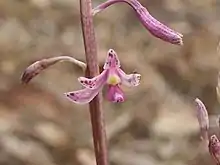| Dipodium elegantulum | |
|---|---|
 | |
| Scientific classification | |
| Kingdom: | Plantae |
| Clade: | Tracheophytes |
| Clade: | Angiosperms |
| Clade: | Monocots |
| Order: | Asparagales |
| Family: | Orchidaceae |
| Subfamily: | Epidendroideae |
| Genus: | Dipodium |
| Species: | D. elegantulum |
| Binomial name | |
| Dipodium elegantulum | |
Dipodium elegantulum, commonly known as the elegant hyacinth orchid, is a leafless orchid that is endemic to Queensland. In spring and summer it has up to sixty pale to dark pink flowers with a few darker spots and streaks near the tips, on a tall flowering stem.
Description
Dipodium elegantulum is a tuberous, perennial, saprophytic herb. Between August and December it produces a flowering stem 500–800 mm (20–31 in) tall bearing between twenty and sixty flowers. The flowers are pale to dark pink with a few darker spots and streaks near the tips and 20–25 mm (0.8–1 in) wide. The dorsal sepal is linear to lance-shaped, 14–17 mm (0.6–0.7 in) long, 3–4 mm (0.1–0.2 in) wide and the lateral sepals are a similar shape but slightly longer and narrower. The petals are a similar shape but slightly curved, 13–15 mm (0.5–0.6 in) long, about 3 mm (0.1 in), free from each other and the sepals. The labellum is dark pink and projects forwards, 14–20 mm (0.6–0.8 in) long, 4–5 mm (0.2–0.2 in) wide with an upturned tip and a narrow central band of mauve hairs up to 0.5 mm (0.02 in) long.[3][4]
Taxonomy and naming
Dipodium atropurpureum was first formally described in 1991 by David Jones and the description was published in Australian Orchid Research from a specimen collected near Mareeba.[1] The specific epithet (elegantulum) is a Latin word meaning "very fine",[5] referring to the flowers of this orchid.[4]
Distribution and habitat
The elegant hyacinth orchid is widespread in forest and grassy woodland between the Mount Windsor Tableland, the Hervey Range and Charters Towers.[3][4]
References
- 1 2 "Dipodium elegantulum". APNI. Retrieved 13 July 2018.
- ↑ "Dipodium elegantulum D.L.Jones". The Plant List version 1.1. Retrieved 25 January 2014.
- 1 2 Jones, David L. (2006). A complete guide to native orchids of Australia including the island territories. Frenchs Forest, N.S.W.: New Holland. p. 271. ISBN 1877069124.
- 1 2 3 Jones, David L. (1991). "New taxa of Australian Orchidaceae". Australian Orchid Research. 2: 50–51.
- ↑ Brown, Roland Wilbur (1956). The Composition of Scientific Words. Washington, D.C.: Smithsonian Institution Press. p. 297.